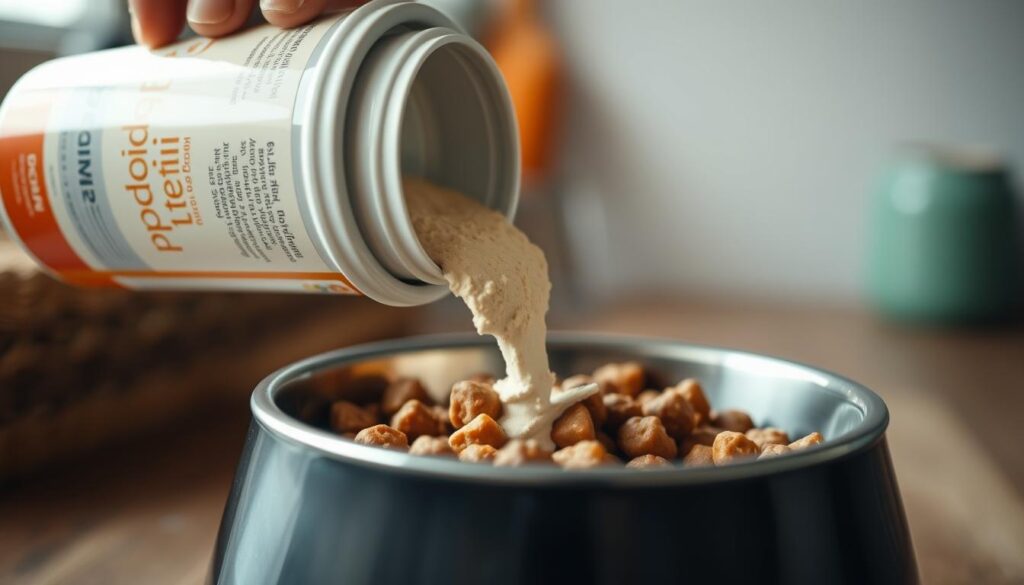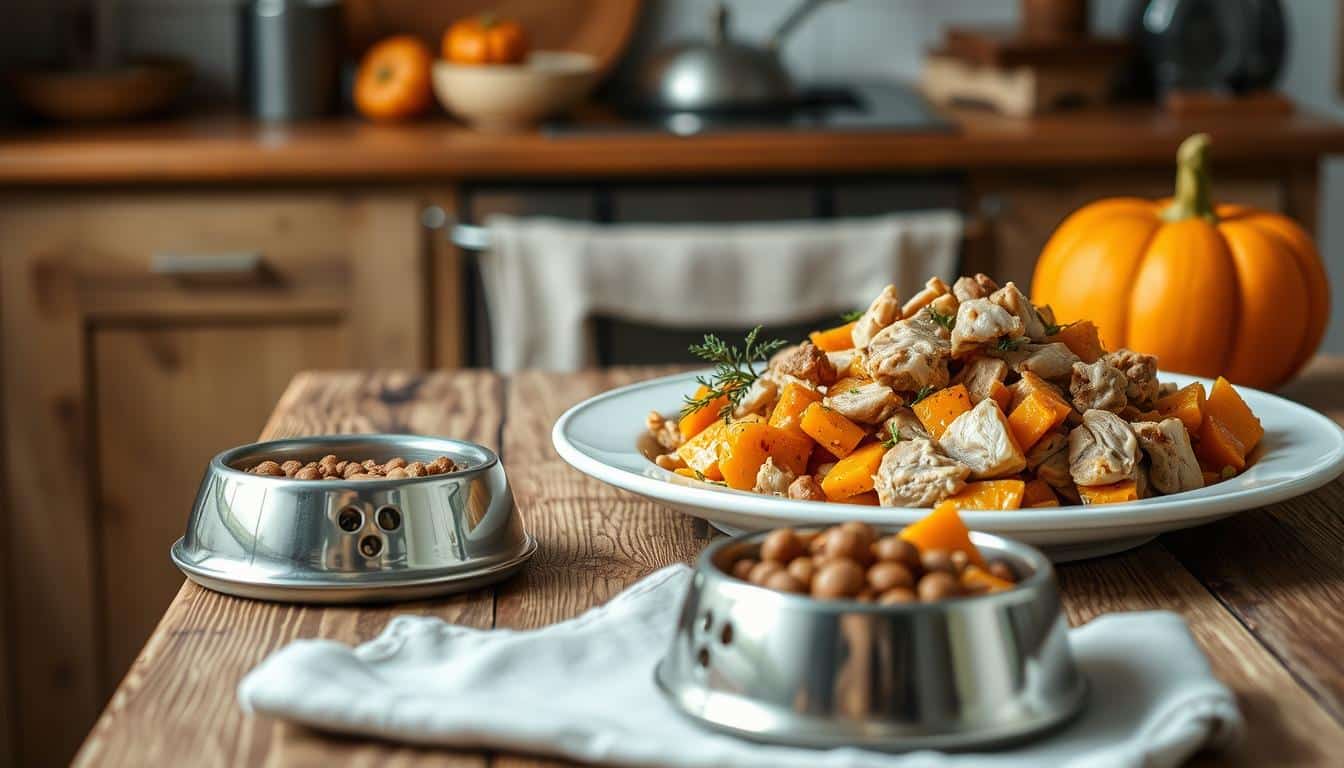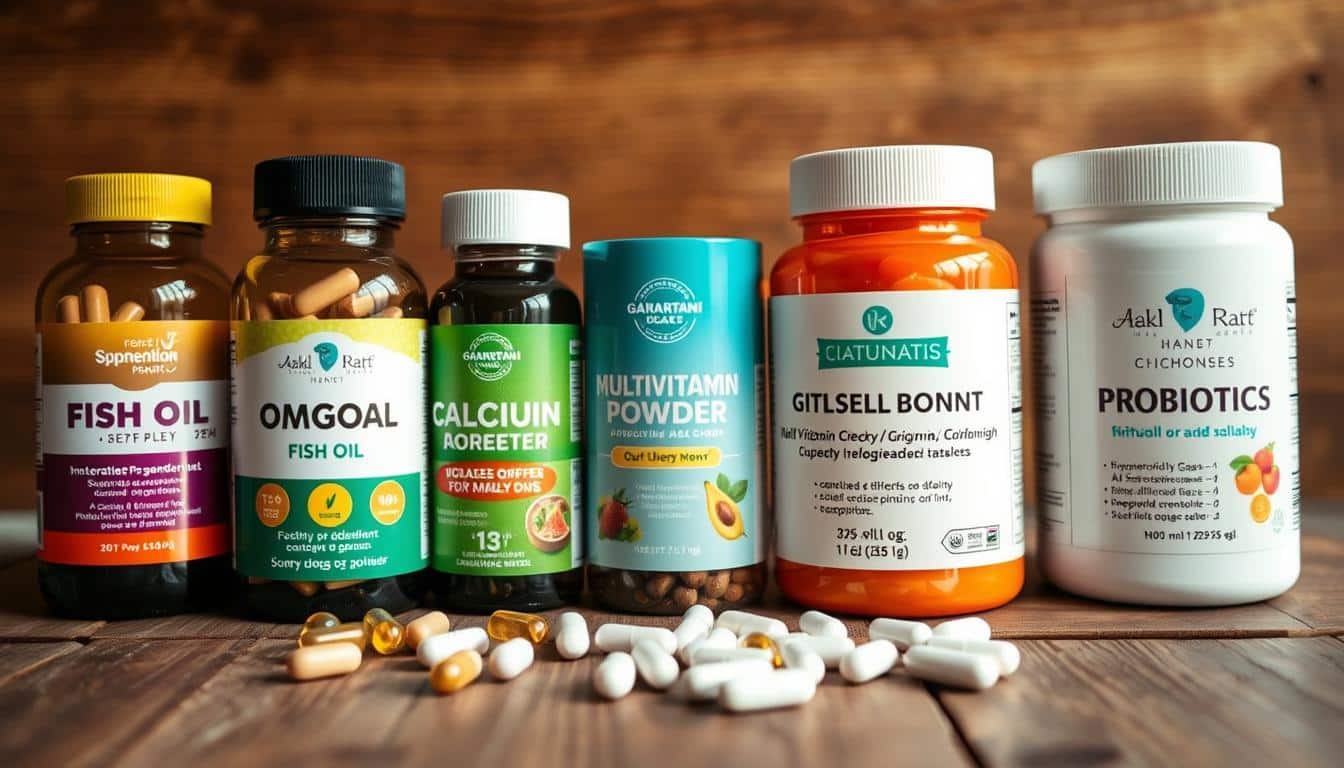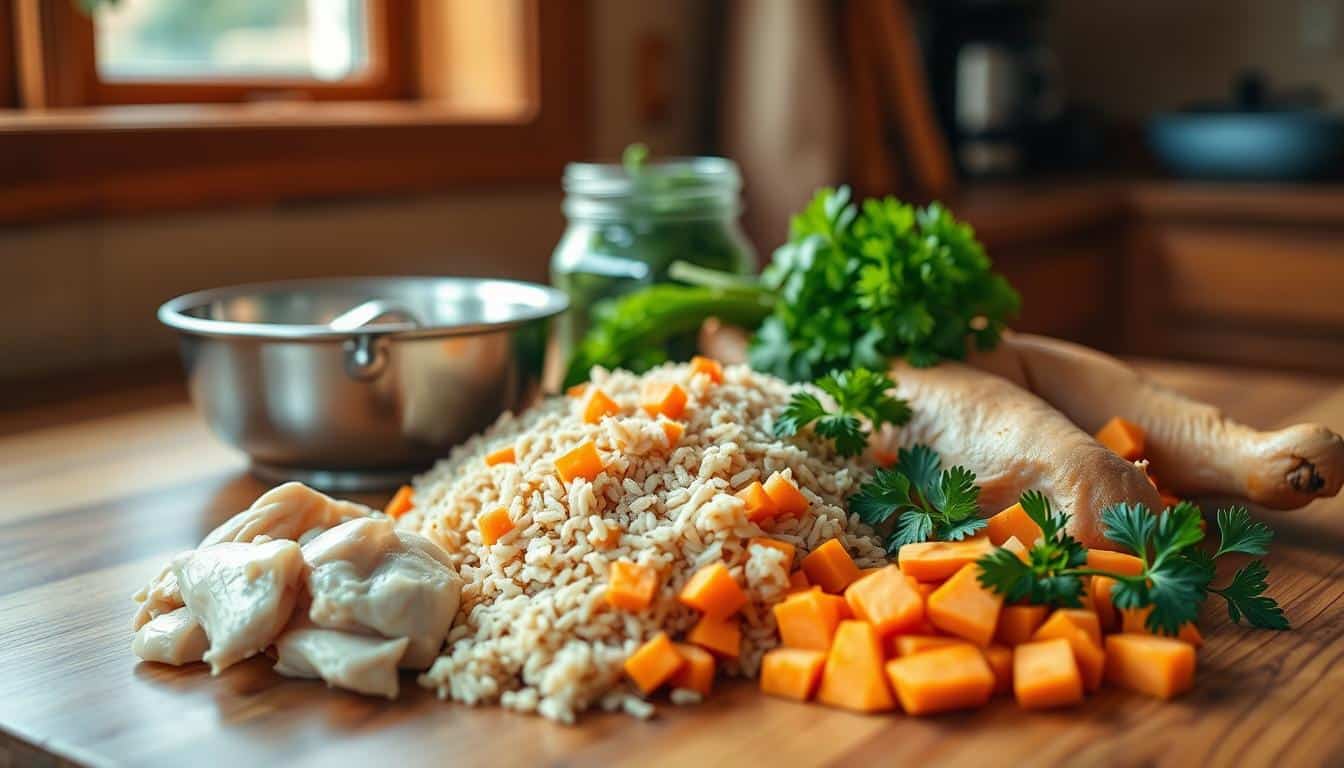This recipe is a vet-friendly solution for dogs with upset stomachs. It’s great if your dog has nausea, loose stool, or doesn’t want to eat. A simple diet like this can stabilize their stomach while you talk to your vet.
The recipe mixes lean ground turkey with easy-to-digest rice. This reduces stomach irritation. It lets owners know exactly what their dogs are eating. It avoids fillers and common problematic ingredients found in store-bought dog food.
You can make this stomach-soothing dog food with items from local stores like H-E-B. It’s affordable and simple to make. This recipe aims to ease digestion, help older dogs and fussy eaters recover, and provides tips for safe serving and storage.
Why homemade gentle meals help dogs with sensitive stomachs
Making gentle meals at home lets pet owners control what their dogs eat. They can choose lean turkey, plain rice, and low-sodium broth. With these, you use fresh ingredients that won’t upset your dog’s stomach.
Control over ingredients and freshness
- Pick known proteins like 93% lean ground turkey to limit fat and irritation.
- Use fresh produce and plain grains to support digestion and appetite.
- Swap store-bought mixes for simple homemade portions when you want to manage sodium and additives.
Removing fillers, preservatives, and hidden irritants
- Commercial kibble and canned blends can contain fillers and added seasonings that worsen sensitivities.
- Home cooking makes it easy to remove fillers preservatives and pre-seasoned ingredients that some dogs cannot tolerate.
- Preparing each meal at home lowers the chance of allergic or inflammatory reactions tied to unknown additives.
When vets recommend bland, home-cooked food
- Veterinarians often advise a vet-recommended bland diet—lean protein with rice—for acute gastrointestinal upset and post-op recovery.
- Clinics and vet techs use this approach to reintroduce foods slowly and watch for reactions.
- Following a bland plan under veterinary guidance can ease digestion, reduce scratching linked to food sensitivity, and help restore appetite and weight when needed.
Rice and turkey recipe for sensitive stomach dogs
This gentle recipe combines lean turkey with easily digestible rice. It soothes the gut and boosts appetite. It’s simple to make, kind to the stomach, and perfect as a recovery meal or kibble topping. It’s adaptable for older pets, dogs recovering from surgery, and fussy eaters.
Core benefits of lean turkey and rice for digestion
- Lean ground turkey (93% or leaner) provides low-fat, high-quality protein. It’s easy on the digestive system.
- White rice and simple grains give quick, gentle carbs. They offer energy without upsetting the stomach.
- Owners often see better appetite and stool consistency with a rice and turkey diet during recovery.
Why white rice may be preferred for acute upset
- White rice digests easier than brown rice because it has no fibrous bran. Vets usually recommend it for acute GI upset.
- Though brown rice has more nutrients and fiber, white rice suits dogs with severe or sudden stomach issues better until they improve.
- White rice helps reduce gut fermentation and firms stools quicker when stomach upset occurs.
How this recipe supports recovery, seniors, and picky eaters
- Soft rice and finely crumbled turkey are easy for old or recovering dogs to eat.
- Warming the meal or adding low-sodium broth may tempt dogs that usually refuse food. This turkey recipe is often liked by picky eaters.
- This mix can be a special treat, turkey dog food approved by a vet for seniors, or a recovery diet while watching their health progress.
Ingredients list: simple, vet-friendly components
Keep your ingredient list short and simple. Stick to real, single-ingredient items from any grocery store. This helps when you need to discuss your pet’s diet with the vet and makes meal prep quick for busy owners.
Recommended protein: ground turkey (93% lean or leaner)
Pick plain ground turkey that’s 93% lean or leaner. Stay away from pre-seasoned or deli meats because they have salt and spices. A standard batch usually needs 1 lb of ground turkey. Use 99% lean turkey for dogs on a very low-fat diet.
Grains: brown rice vs. white rice and when to choose each
Brown rice offers more fiber and nutrients, aiding regular digestion and adding texture. Use white rice for dogs with an upset stomach as it’s easier to digest and aids recovery. A common amount for a balanced batch is 1 cup of uncooked brown rice. Switch to white rice for dogs with vomiting or diarrhea.
Vegetables that are gentle and safe: carrot, zucchini, spinach
- Carrot: shred finely for beta-carotene and gentle fiber.
- Zucchini: shred or chop small for vitamin C and potassium.
- Spinach: use sparingly, finely chopped to avoid large oxalate loads.
Dogs tend to tolerate fresh vegetables better when they’re cut into small pieces. These veggies are safe for dogs and add nutrients without upsetting their stomachs.
Optional additions: low-sodium broth, pumpkin, substitutes for allergies
Add moisture to the food with low-sodium broth preferred by dog owners, or use plain water to avoid sodium. Canned pumpkin in small amounts helps with stool regulation and adds fiber.
- Allergy swaps: green beans, peas, sweet potato, or quinoa for those avoiding grains.
- Healthy fats: a teaspoon of olive oil or sunflower oil can increase calories, but talk to your vet first.
A common shopping list mentioned by pet owners: 1 lb turkey $4.50, 1 cup brown rice $0.60, ½ cup zucchini $0.50, ½ cup carrot $0.40, 1 cup spinach $0.80. This comes to about $6.80 for around 8 cups of homemade dog food.
Step-by-step recipe and cooking method
Start with a peaceful kitchen and simple tools. This guide explains how to prepare rice for dogs. It also shows how to cook ground turkey safely for dog food. Plus, it covers when to add vegetables and how to cool the food to a safe temperature for dogs.
Cooking the rice properly for better digestibility
- Wash the rice until the water is clear. White rice is best for a gentle texture and upset stomachs.
- Follow the instructions on the package. You can use a rice cooker or cook it on the stove. Make sure the grains get very soft.
- After cooking, let the rice sit off the heat. This helps it absorb any remaining water. Then, fluff it gently with a fork.
Preparing and cooking ground turkey safely
- Pick ground turkey that’s at least 93% lean. Avoid meat with added seasoning or salt.
- Cook the turkey over medium heat. As it cooks, break it into small bits. Make sure there is no pink left and it reaches 165°F inside.
- If needed, get rid of any extra fat. Then, mix the turkey back in the pan with rice or broth to add moisture.
How and when to add vegetables for texture and nutrient retention
- Shred carrots and zucchini finely. Cut spinach into tiny bits.
- Put the veggies in after the turkey is fully cooked. Cook them for 2-3 minutes until they’re soft. This keeps the nutrients in and helps with digestion.
- If your dog has a tender mouth, blend the cooked veggies. Then, mix them into the food for a smoother feel.
Cooling, portioning, and safe serving temperatures
- Let the cooked food cool down faster by spreading it in a shallow dish. Never serve it hot.
- Dogs like their food slightly warm or at room temperature. Test the food on your wrist to ensure it feels neutral.
- Divide the food based on your dog’s size and how active they are. You can keep it in the fridge in airtight containers for up to 5 days. Or, freeze it for up to 2 months.
Portioning, storage, and meal prep tips for busy owners
Preparing meals at home helps keep your sensitive dog healthy. Start simple: define portion sizes and set up a workflow. This saves time and reduces waste, keeping your dog’s meals safe and easy to manage.
Let’s start with how much to feed. For small dogs (10–20 lbs), ½–1 cup a day in two meals. Medium dogs (20–50 lbs) need 1½–3 cups daily. Large dogs (50–80 lbs) eat 3–4½ cups a day. For the biggest dogs (over 80 lbs), 4½–6 cups. Always adjust for age, how active your dog is, and your vet’s advice.
Batch cooking is a time-saver. Many people cook extra and then freeze dog food in daily servings. This way, you only need to reheat each meal. It’s a smart move for those with little time.
- Cool food completely before divvying it up.
- Store in airtight containers or freezer bags.
- Measure portions to suit your pet’s dietary needs.
It’s important to freeze and thaw food correctly to keep it safe. Let food cool, then freeze in labeled containers. Thaw in the fridge for 1-2 days before mealtime. Small portions thaw overnight, bigger batches may take up to 48 hours.
When reheating, aim for just warm to touch and stir well. Avoid microwaving in unsafe plastics. Or, simply serve cold if your dog doesn’t mind.
Labeling is key, especially when feeding multiple dogs. Note the date, portion, and pet’s name on each container. Prepare by cooking and combining ingredients, cooling, portioning, labeling, then freezing.
- Cook rice and protein; let them cool a bit.
- Add vegetables and some low-sodium broth.
- Portion into containers, seal, and label with date and amount.
- Then freeze or refrigerate, depending on when you’ll use them.
For longer storage, freeze dog food in five-day batches or single meals. Freeze some and keep some in the fridge for easy access. With clear labels and a rotation system, you’ll waste less and make mealtime smoother.
Remember these keywords: portion sizes homemade dog food, freeze dog food, meal prep dog food, and thawing homemade dog meals. They’re your guide to making homemade meals manageable, even for the busiest pet owners.
Customizing the recipe for allergies, calories, and life stages
Start by thinking about what your dog needs. Small changes can ease allergies, help them reach a healthy weight, or support their growth. Change one thing at a time and note how it affects their appetite, stool, and energy.

Protein swaps and grain-free alternatives
- Swap ground turkey for ground chicken, lean beef, ground lamb, or cooked deboned white fish to test for sensitivities.
- If grains cause symptoms, try grain-free options like cooked quinoa, mashed sweet potato, or roasted butternut squash.
- Introduce offal like heart or liver slowly and in small amounts. Always check with your vet before making organ meats a regular diet item.
Adjusting fat and calories for weight loss or gain
- To help your dog lose weight, pick extra-lean turkey (99% lean), reduce rice, and add low-starch veggies like green beans or zucchini.
- For weight gain or for growing puppies, add calories with healthy fats like olive oil or sunflower oil. Include calorie-dense foods like canned salmon in moderation.
- Work with your vet to adjust your dog’s calorie intake safely. They’ll help calculate the right portion sizes based on age, activity, and body condition.
How to introduce changes gradually to avoid digestive upset
- Introduce new foods slowly over multiple meals. Start with 10% new food and increase by 10% every two to three days while looking for reactions.
- Mix some homemade food with their current commercial food. This smooth transition helps, especially for puppies or dogs on special diets.
- Keep an eye out for intolerance signs and stop if you see vomiting, diarrhea, or skin issues. Go back to the last food mix they tolerated and talk to your vet if problems continue.
Long-term home cooking means seeing the vet often. Your vet can suggest supplements like calcium, omega-3s, or a balanced multivitamin. These keep the diet complete and support each stage of life.
Safety, vet guidance, and common mistakes to avoid
Making homemade meals for dogs with sensitive tummies can be helpful, but it’s important to be safe. Some common foods can be dangerous. Always stick to safe recipes and see how your dog reacts to new diets.
Ingredients to never use
- Garlic and onions in any form — powdered, raw, cooked, or in mixes — are toxic and must be avoided.
- Too much salt and table seasonings can harm digestion and kidneys.
- Pre-seasoned meats and spice blends often have garlic, onion, or a lot of salt and are bad choices.
When to consult your veterinarian and consider supplements
Always talk to a vet you trust before changing your dog’s diet. This is crucial for puppies, pregnant dogs, older dogs, or those with illness. Ask them about homemade food to avoid missing out on important nutrients.
- Homemade diets might need added calcium, vitamin D, or omega-3s to be balanced.
- Animal doctors from places like Banfield or VCA can do tests and suggest supplements or store-bought food if needed.
- Arrange for regular checks on weight, lab results, and health signs to catch problems early.
Signs the homemade diet is helping or causing issues
Keep an eye on your dog for any good or bad changes. Seeing positive changes means your homemade diet plan is working.
- Better appetite, solid poop, less itching, and more energy are good signs.
- If an underweight pet gains weight or has fewer skin problems, the recipe is good for them.
- But if your dog has ongoing diarrhea, vomits, loses weight, scratches more, or seems tired, contact your vet at once.
Track what your dog eats and any reactions they have. Detailed records help your vet find problems and give advice. Being thorough ensures safe and beneficial homemade meals for your pet.
Real-life results and benefits from pet owners
Many owners see big changes from making simple, home-cooked meals for their pets. They share stories of less scratching and better digestion. These true stories show how homemade meals make everyday life better for pets.
Improvements in itching, sores, and skin issues after switching
A Yorkie owner saw back sores and scratching get better in just weeks with a new diet and an oatmeal bath. Removing commercial food that might cause problems often helps skin heal faster. Following a vet’s advice and changing food can lessen itching and calm sore skin.
Success stories: picky eaters, seniors, and recovery cases
Tanah, a 10-year-old mix, loved her turkey-and-rice meals every day, leading to better digestion and steady weight. Stories show simple, tasty meals work great for pets that are hard to please. One puppy with stomach problems got better with big batches of chicken-and-rice, watched by a vet.
Cost comparison and peace-of-mind benefits
When owners do the math, they often find homemade food is a good deal. For example, making about eight cups costs roughly $6.80, or $0.90 per cup. This is often cheaper than high-end kibble.
- Budget: batch-cooking lowers the cost per meal and cuts down on waste.
- Quality: when you know what’s in the food, you avoid harmful ingredients.
- Flexibility: you can change up recipes to suit your dog’s dietary needs.
These stories prove the benefits of making dog food at home are both practical and emotional. Owners take charge of the ingredients, solve issues for picky eaters, and see health improvements. Many feel the cost and knowing about the food’s freshness and safety is worth the effort.
Conclusion
This rice and turkey recipe is a great choice for dogs with sensitive stomachs. Vets often suggest it for dogs needing a gentle diet. It’s a basic mix that’s easy to make and helps dogs recover.
Lean turkey meat is great because it’s easy for dogs to digest. Fully cooked rice is soothing for their stomach. This simple dog food helps avoid irritation and is easy for owners to prepare.
For the best meal, pick turkey that’s at least 93% lean. Choose white rice for upset tummies or brown rice for more nutrients. You can also add steamed carrot or zucchini. Remember, no seasonings or salt. Make sure the rice is well cooked and the turkey is browned. Let the food cool down before giving it to your dog.
Keep leftovers in the fridge for up to five days. You can also freeze meals for up to two months. When changing your dog’s diet, start with small amounts. Watch how their skin and poop look to make sure they’re doing well. Talk to your vet if you’re thinking about making homemade food a regular thing.
Many pet owners say their dogs eat better and have healthier skin when they use this recipe. They also save money. This rice and turkey dog food is a safe, effective way to help with stomach issues. It gives owners a way to take good care of their pets.
FAQ
What is the Gentle Rice & Turkey recipe and who is it for?
Why do homemade meals help dogs with sensitive stomachs?
How does making food at home remove fillers and hidden irritants?
When will a veterinarian recommend a bland, home-cooked diet?
What are the core benefits of lean turkey and rice for digestion?
Should I use white rice or brown rice?
How does this recipe help seniors, picky eaters, and recovering dogs?
What protein should I use and what should I avoid?
How much rice and what grain options are best?
Which vegetables are safe and how should I prepare them?
What optional additions can I use to improve palatability and digestion?
How do I cook rice for better digestibility?
How should I prepare and cook ground turkey safely?
When and how should I add vegetables during cooking?
What cooling, portioning, and serving temperature practices should I follow?
How much should I feed my dog? Are there general portion guidelines?
What are best practices for batch cooking, freezing, and thawing?
How should I label and organize portions when feeding multiple pets?
What protein swaps and grain-free alternatives are safe?
How do I adjust fat and calories for weight loss or gain?
How should I introduce new ingredients to avoid digestive upset?
Which ingredients should I never use?
When should I consult my veterinarian or consider supplements?
What signs show the homemade diet is helping or causing problems?
Have owners seen improvements in itching, sores, or skin issues after switching?
Are there success stories for picky eaters, seniors, and recovery cases?
How does the cost of homemade compare to commercial foods?
Content created with the help of Artificial Intelligence.



